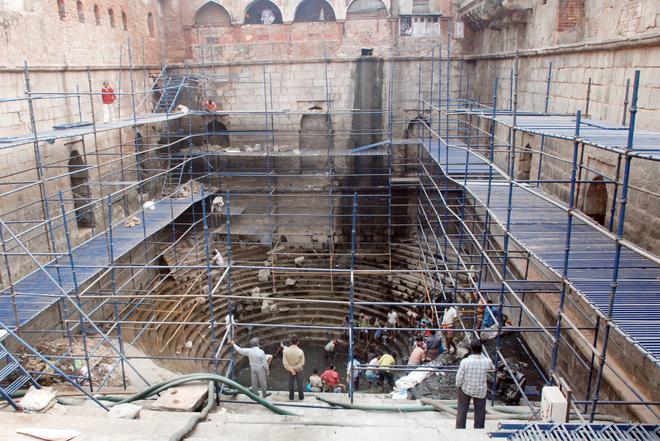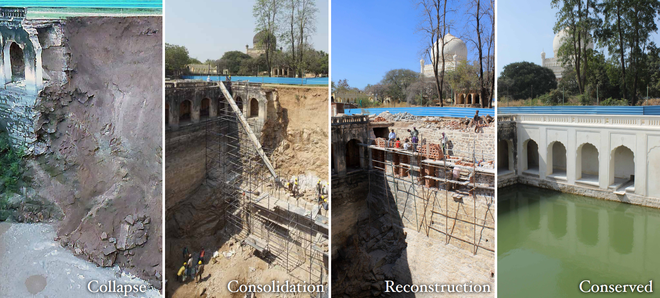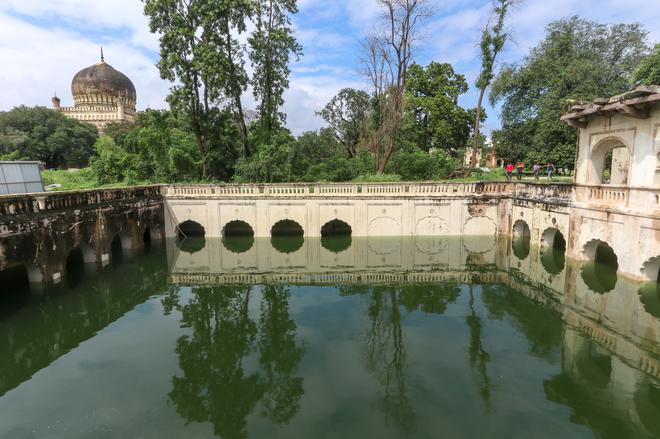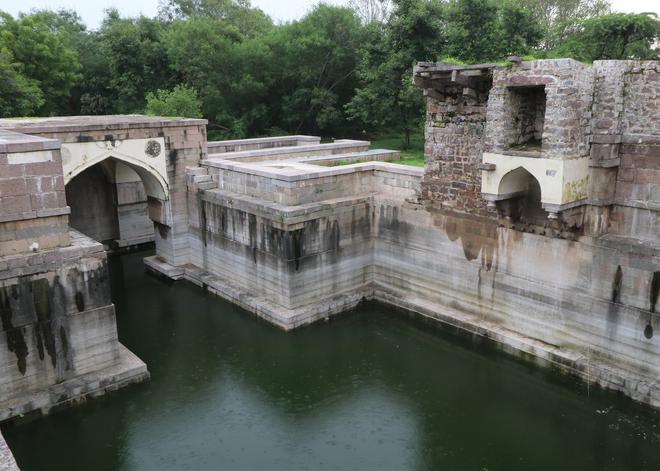There is a story about the over 700-year-old Nizamuddin Baoli built by Delhi’s most famous saint. It’s said that Sufi Hazrat Nizamuddin Auliya began the baoli’s (stepwell) construction by digging the earth with his own hands and uttering the blessing, ‘He who drinks one drop of it should have no fear of the fire of hell.’
There are other fantastical tales, too, associated with the baoli. It is said that when sultan Ghiyas-ud-din Tughlaq of Delhi (1320-1325) started constructing the massive Tughlaqabad Fort, he prohibited all other construction in the city. But workers would still come to build the baoli after sunset. The sultan, while on his way back from a visit to Bengal, sent Auliya a message to leave the city. The saint wrote back: “Delhi is still far away.” The sultan died in an accident on the outskirts of Delhi. The fact that the sultan’s nephew — who erected the pandal that fell and killed him — was a disciple of the saint, is lesser known but pertinent.
Why was Hazrat Nizamuddin ready to foment a revolution to build a water reservoir that he would never enjoy himself? Possibly for the same reason that the Aga Khan Trust for Culture (AKTC), founded and chaired by His Highness the Aga Khan, has been working on restoring water bodies, including eight baolis, in Delhi and Hyderabad. Maybe they both understood that being around blue and green spaces has tremendous physical and mental benefits for humans. (Studies in the Netherlands and Japan have shown that people with easy access to such spaces boasted better health, lower stress levels, and lower mortality rates.)
Assets in need of saving
Nizamuddin Baoli wasn’t the only such space built in Delhi. However, today, only their names remain: Dhaula Kuan (white well); Chappar Wala Kuh (thatched well) at the Karol Bagh crossing; Panchkuian Road (five well road); Khari Baoli (brackish stepwell); and Janta Piao, one of the oldest wells in Old Delhi.
“There were over 100 baolis at the turn of the 20th century. Every time a baoli wall collapsed, people just filled it up and built over it,” says Ratish Nanda, projects director of AKTC, who put together the ongoing exhibition, Baolis: Restoring Stepwells, Providing Life to showcase the conservation of eight — from the Qutb Shahi Heritage Park in Golconda, Hyderabad, to the Nizamuddin Baoil and Arab Serai Baoli in Humayun’s Tomb, as well as the Mughal era wells at Sunder Nursery in Delhi.
“The All-India Council of Technical Education has created a scheme to document baolis across the country — by engineering and architectural colleges. I believe there would be at least 10,000 baolis in India and 20,000 water structures. Every village has its tank. Every mosque, temple, and gurudwara had a tank,” he says. “What we need to demonstrate now is that these are incredible economic and ecological assets.”
Nanda believes that the NREGA (National Rural Employment Guarantee Act) funds — ₹600 crore in 2023 — could be used by municipal corporations or the Archaeological Survey of India to revive and desilt historic wells and ensure every village has a tank. “We spend so much money creating water tanks for rainwater harvesting when the tanks already exist. [Under the government’s Jal Shakti Abhiyan scheme, for instance, ₹2 lakh is given to every district to map water bodies and prepare a plan to collect rain water.]”
Circular steps and a secret passage
When the Nizamuddin Baoli collapsed in 2008, there was talk of filling it up. But the AKTC stepped in. They had to remove 40 feet of sludge and layers of epoxy that were making the remaining walls bulge. They worked with the community, and built 18 alternate flats for people who lived above the baoli. One of the residents voluntarily moved back his house, built by his grandfather, by six feet. As work progressed, the baoli revealed itself to be a freshwater spring with exquisite circular steps and a secret passage to the dargah.

Across the road at Humayun’s Tomb, AKTC created 128 groundwater and rainwater recharge pits when they started restoring the gardens in 1997. In the decades that followed, they also discovered and desilted five wells that had been filled up, and restored the Arab Sarai Baoli, which was built in emperor Jahangir’s times. “The walls of the baoli were bulging, and in a state of collapse. One of the upper arches had already collapsed. So, we had to reconstruct all of that,” says Ujjwala Menon, senior programme officer at AKTC. “After we cleaned it up, the water level started rising till the lower level was covered.” The baoli, which was built from rubble masonry, has large vaulted chambers and a unique ‘L’ shape. It now attracts water striders and dragonflies, which Menon says are signs of clean water.
Water surplus in Hyderabad
AKTC also started to work on restoring the famed Qutb Shahi necropolis near the Golconda Fort in 2013. The complex dates back to the 16th century and consists of 100 monuments spread over 106 acres, including baolis that provided water for the orchards. With the collapse or filling-in of these stepwells, the orchards died out by the 19th century. At least two known baolis have been lost, their stone probably quarried in the 19th and 20th centuries.
After the restoration, all six baolis — called the Bagh, Eastern, Badi, Idgah, Western and Hammam — are rainwater harvesting tanks with a combined capacity of 19.2 million litres. “Construction requires a lot of water. To buy water for 100 monuments required at least 20 tankers a day. Now, we have a water surplus,” says Nanda. “We collect two crore litres every monsoon with which we’ve planted 10,000 trees and will plant another 4,000.”



Both the Delhi and Hyderabad projects have won UNESCO awards, and the reconstruction process can be followed at the exhibition. In May this year, the Telangana government launched three new projects with AKTC. But for people across India, the exhibition is a lesson in how easily existing blue and green spaces can be restored and maintained.
Restoring Stepwells is on at Sunder Nursery till October 1.
The writer is the author of a fantasy series, and an expert on South Asian art and culture.







